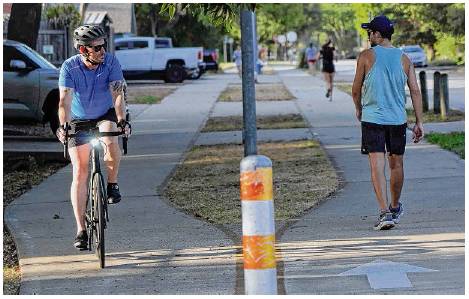Supporters push for bike trail honoring former city official
By Dug Begley STAFF WRITER
Friends remember Pat Walsh as someone who saw the big picture of what Houston could be, and the little details necessary to get a massive city bureaucracy headed in the right direction. Now they want the former planning director’s name on a big new bikeway, perhaps fittingly made up of some of the incremental improvements he helped come to fruition.
“It is important that contribution be remembered,” said Kevin Strickland, one of the proponents of the bikeway’s creation.
If the idea can wind its way through the city’s processes, some Walsh helped craft, the 9-mile Pat Walsh Bikeway would connect Loop 610 north of the Heights to Loop 610 south of NRG Park.
“A big part of the strategy here is letting people know with one bikeway they can cross the city,” said Emmanuel Nunez, one of the people pressing for the bikeway, which would include many long-sought connections in the existing trail system.
The proposal was approved Wednesday by the infrastructure committee of Houston’s Bicycle Advisory Committee, the first of many uphill paths the proposal faces to become an official designation.
Walsh was Houston’s planning director from 2014 to 2018, when he died at 45 from an aggressive form of brain cancer detected that summer. Despite his short time leading the department, his impact has been immense on the city’s growth, Strickland said, and the expansion of bike lanes in the city.
“Pat had a unique ability to explain a vision of how we were going to get there and then the steps to get there,” Strickland said. “A lot of people are good at one of those things. He was good at all of that.”
Mayor Sylvester Turner has credited Walsh with helping craft Turner’s call for a “paradigm shift” in the city’s transportation network. In 2018, Turner said an appropriate tribute would be to name a trail segment after Walsh.
Houston officials approved the city’s comprehensive bike plan in 2017, after months of work by Walsh and other planners to lay out a vision of 500 miles of on- and off-street trails aimed at laying access to cycling routes across the entire city, while maintaining major hike and bike routes along bayous and solving inevitable conflict spots with the city’s major streets and freeways.
“We are now reaping the benefits of his work,” bike advisory committee member Robin Holzer said.
The bikeway dedicated to Walsh would stretch from the Heights, where the existing bike trail along Nicholson ends at 26th Street, to the new bike path along Almeda to Loop 610 near NRG Park, a distance of around 9 miles. Between the Heights and NRG, the bikeway would be stitched together by connections to Patterson Street where improvements are planned to its crossing at Washington Avenue, along the Jackson Hill Bridge that connects to the Buffalo Bayou trail system, and along Woodhead and Alumni where cyclists share the road with drivers on neighborhood streets that cross many major intersections.
“We want this to be a bike-way that connects many parts of the city,” Nunez said.
If built, it also becomes a major north-south spine for cyclists who already have good east-west connections along Houston’s bayou trail system. Linked by the proposed Walsh bikeway, Nunez said, many other neighborhoods can claim accessible, safe bike routes.
Key to the bikeway’s design — which would incorporate signs designating it for Walsh — would be what Nunez called a “train stop approach” to directions along the path denoting major locations and interest points. The design mimics that of light rail stations, showing the order on a simple line with some indication, perhaps, of cycling times and distances between the stops.
“This is only going to be useful if it is stitched together,” Nunez said.
The dedication has the support of Walsh’s family, according to his widow, Lindsey Aldrich Walsh.
“It is something I am willing to show up and speak for,” she told members of the bike committee.
The process, however, might take a lot of meetings. City rules governing the naming of streets and other public spaces — regulations Walsh coincidentally helped write during a debate over the naming of Emancipation Boulevard — govern the process.
“It is not short,” Houston Chief Transportation Planner David Fields said. “It takes a little time.”
The bicycle committee, which meets again in October, can at that time or later approve a recommendation for the bike-way to bear Walsh’s name. From there, Fields said city staff will take that approval to Turner, who then must assign a department to report on the potential change and its impacts. Officials also would notify and potentially seek the approval of neighborhood groups in the area around the bikeway — which crosses more than a dozen civic club boundaries.
City Council would eventually have to give its blessing to the change as well. Not to mention the connections that would have to be made taking the various segments and stitching them together.
Advocates of the bikeway said they’re willing to put in the time to see Walsh get a fitting tribute.
It is also, Strickland said, a legacy project. If approved along the route he and Nunez propose, the Walsh bikeway will go along Woodhead near where Walsh used to live and where his son, Julian, who was an infant when Walsh died, still resides. Now 6, he is starting to hit the streets on his own bike.
“That is important to us,” Strickland said. “It is going to go right past their house. Julian will get to ride on it.”

